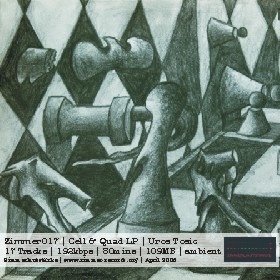Zimmer017 – Uros Tosic – Cell & Quad LP (Serbia)
mp3, 192kbps, stereo, ambient, experimental
017.01 – uros tosic – low frequency pain
017.02 – uros tosic – it is coming
017.03 – uros tosic – reprogramming song
017.04 – uros tosic – horror organs
017.05 – uros tosic – digital holocaust
017.06 – uros tosic – fear of unknown space
017.07 – uros tosic – the sacred mushroom
017.08 – uros tosic – at dawn they sleep
017.09 – uros tosic – brain devastation
017.10 – uros tosic – ambient bells
017.11 – uros tosic – night
017.12 – uros tosic – on the dark trail
017.13 – uros tosic – blue water
017.14 – uros tosic – lucid dreams
017.15 – uros tosic – bells of horror
017.16 – uros tosic – farewell
017.17 – uros tosic – the poet
download & stream -> archive.org
download & stream -> sonicsquirrel.net
download & stream -> last.fm
download ZIP (MP3 | 109MB)
Artwork (666px)
[by nadrealizam]
The speed of light in vacuum, commonly denoted c, is a universal physical constant important in many areas of physics. Its value is exactly 299,792,458 metres per second, a figure that is exact because the length of the metre is defined from this constant and the international standard for time. This is, to three significant figures, 186,000 miles per second, or about 671 million miles per hour. According to special relativity, c is the maximum speed at which all matter and information in the universe can travel. It is the speed at which all massless particles and changes of the associated fields (including electromagnetic radiation such as light and gravitational waves) travel in vacuum. Such particles and waves travel at c regardless of the motion of the source or the inertial frame of reference of the observer. In the theory of relativity, c interrelates space and time, and also appears in the famous equation of mass–energy equivalence E = mc2.
The speed at which light propagates through transparent materials, such as glass or air, is less than c. The ratio between c and the speed v at which light travels in a material is called the refractive index n of the material (n = c / v). For example, for visible light the refractive index of glass is typically around 1.5, meaning that light in glass travels at c / 1.5 ≈ 200000 km/s; the refractive index of air for visible light is 1.000293, so the speed of light in air is 299705 km/s or about 88 km/s slower than c.
In some cases, light and other electromagnetic waves can be thought to be moving “instantaneously”, but for long distances and very sensitive measurements their finite speed has noticeable effects. In communicating with distant space probes, it can take minutes to hours for a message to get from Earth to the spacecraft, or vice versa. The light we see from stars left them many years ago, allowing us to study the history of the universe by looking at distant objects. The finite speed of light also limits the theoretical maximum speed of computers, since information must be sent within the computer from chip to chip. The speed of light can be used with time of flight measurements to measure large distances to high precision.
Ole Rømer first demonstrated in 1676 that light travelled at a finite speed (as opposed to instantaneously) by studying the apparent motion of Jupiter’s moon Io. In 1865, James Clerk Maxwell proposed that light was an electromagnetic wave, and therefore travelled at the speed c appearing in his theory of electromagnetism. In 1905, Albert Einstein postulated that the speed of light with respect to any inertial frame is independent of the motion of the light source,and explored the consequences of that postulate by deriving the special theory of relativity and showing that the parameter c had relevance outside of the context of light and electromagnetism. After centuries of increasingly precise measurements, in 1975 the speed of light was known to be 299792458 m/s with a measurement uncertainty of 4 parts per billion. In 1983, the metre was redefined in the International System of Units (SI) as the distance travelled by light in vacuum in 1/299,792,458 of a second. As a result, the numerical value of c in metres per second is now fixed exactly by the definition of the metre. //wikipedia.com
